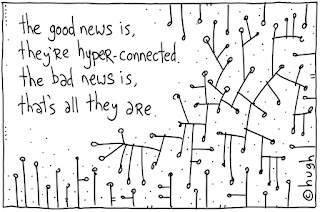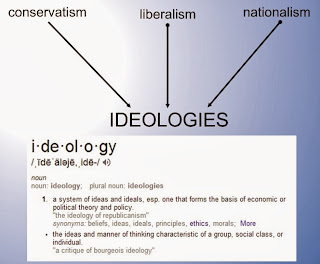Connected... But Not Making Connections
I recently read two different blogs with interesting graphics that got me thinking about this.
First, Dean Shareski (an edu-blogger I have referenced in past posts) wrote Why Audience Matters. He quoted a member of his PLN, Chris Lehmann, who asked, "When having audience is no longer novel, simply having one is no longer motivating. We still must help kids have something powerful to say."
He illustrated the point with a cartoon by Hugh MacLeod (MacLeod doesn't always use kid-friendly language...just a warning).
The second blog I read that mentioned similar ideas is called I Don't Need Your Network by Will Richardson. He asks a lot of great questions in this post, but what really meant the most to me was this image of a classroom:

Richardson asks, "I wonder how many educators look at that picture and think 'OMG, puhleeeese let me teach in that classroom!' (I suspect not many.)" As much as I love the 1:1 computer ratio, I wonder how it detracts from the human connections and social skills (NOT social networking skills) that are essential for success in the adult workforce.
Sometimes it can seem daunting to teach content, skills, technology, and manners (which I think we should teach, by the way) all at the same time. Imagine how our students feel as they sit in the classroom. They must feel like the last kid left on a losing team in a game of dodgeball, pelted from all sides with an overwhelming amount of information.
YIKES! (Image reused with permission from The Met Online)
So is being connected enough?
I say, "NO!"
We need to also teach our students how to maintain those connections and develop relationships. Sure, they can learn from the Internet, but they can't live their lives behind a computer screen (or a mobile touch screen). It isn't healthy or normal, and it would mean they are missing out on the riches that face-to-face interaction provide in our lives.



.jpg)
My students complain about the school policy of banning cell phone use during school hours--"even between classes and at lunch" they whine! Your post is precisely why we need to hold firm. As the age that children get their first cell phone gets younger and younger (in my town it's now by 5th grade), I imagine in the future we will have to teach f2f skills---as if we didn't have enough to prepare them for already!
ReplyDeleteI think a few skills have been mastered. 1. The art of multi-tasking. In this century, if you do not multi-task well you can be left behind. If a student is doing homework, IM'ing, and such at the same time, and he can still achieve good grades and command knowledge of the material--this is efficient multi-tasking. 2. The ability to assist others in need more efficiently. During homework, or projects, if a student cannot understand part of the work or if that student missed a day due to illness, I have found that other students readily jump in via IM'ing or texting or other means to get that student up to speed. The assistance aspect of socialization has improved quite a bit with technology. 3. Group projects are not as arduous any longer. Working with someone by emailing information, charting graphics, IM'ing thoughts/concerns in preparation for the "project due" date has improved substantially due to the networking and connections of technology.
ReplyDeleteThere are negatives. During the turbulent adolescent years, if there is a student who is abusing the technology (bullying via Facebook or Myspace), this can cause a student to revert into themselves and not discuss with their parents or other adults what is going on in their world and how to stop it. Plus, there is nothing easier than for a person to be mean-spirited over a keyboard and to totally destroy someone with just a few keyboard strokes.
So--like everything...positives and negatives. As always, keeping communication open and keeping the technology at a limit is essential for EVERYONE.